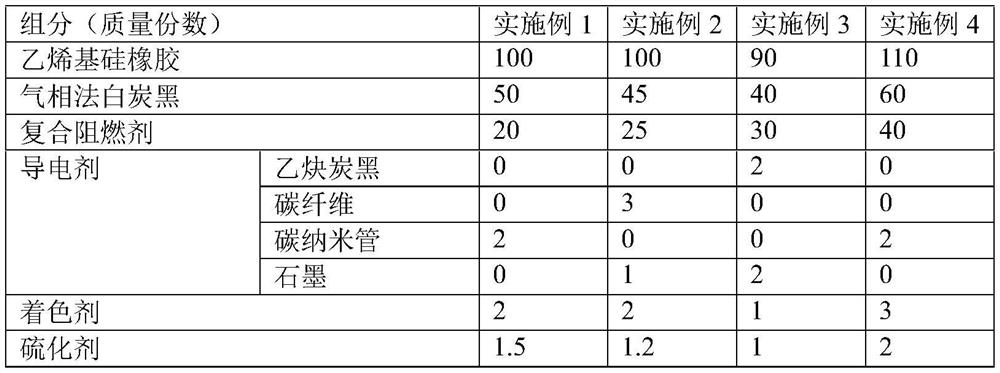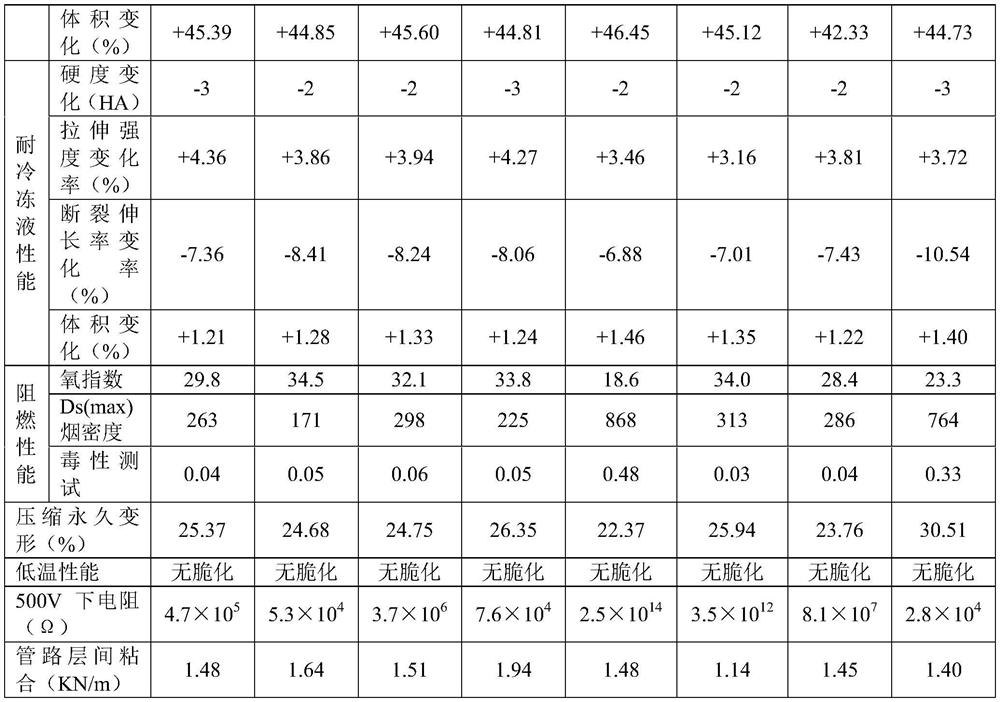Rubber for low-resistance flame-retardant fuel cell transmission pipeline
A fuel cell and transmission pipeline technology, applied in the field of rubber materials, can solve problems such as inability to discharge static electricity, high resistance, poor flame retardancy, etc., to improve dispersion and compatibility, reduce resistance, and enhance flame retardancy. Effect
- Summary
- Abstract
- Description
- Claims
- Application Information
AI Technical Summary
Problems solved by technology
Method used
Image
Examples
Embodiment 1-4
[0025] The preparation method of the high-pressure and high-temperature resistant high-resistance cooling pipeline rubber of the present invention is as follows: 1) kneading: after weighing each material according to the mass ratio, add the materials except the vulcanizing agent into the kneader and knead evenly; 2) plasticizing : Add the mixed rubber in the internal mixer, add the vulcanizing agent to make the mixed rubber for use; 3) Vulcanization: vulcanize the mixed rubber on the vulcanizing machine, the vulcanization temperature is 170 ℃, the pressure is 10 MPa, and the time is After 10 minutes, the glue is discharged and cooled, and the rubber for the transmission pipeline of the low-resistance flame-retardant fuel cell is obtained after the glue is discharged.
[0026] The raw material ratios in Examples 1-4 are shown in Table 1. Wherein, the polypyrrole nanotube composite flame retardant is obtained according to the preparation method of Example 5, the conductive agent...
Embodiment 5
[0029] Example 5: Preparation of polypyrrole nanotube composite flame retardant
[0030] (1) Synthesis of polypyrrole nanotubes: Dissolve pyrrole and dopant in deionized water, then add an oxidant, the dopant is methyl orange, the mass ratio of pyrrole to dopant is 3.5:1, and the oxidant is chloride The material ratio of iron, pyrrole and oxidant is 5:1, mixed and reacted for 30h, filtered, washed and dried at 25°C for 48h to obtain polypyrrole nanotubes;
[0031] (2) Synthesis of polypyrrole nanotube composite flame retardant: disperse the polypyrrole nanotube obtained in step (1) in a 1 mol / L magnesium chloride solution, the mass ratio of magnesium chloride solution to polypyrrole is 250:1, and after stirring evenly Ammonia water is added until the pH is 9-10, the reaction is allowed to stand for 6 hours, and the polypyrrole nanotube composite flame retardant is obtained after filtering, washing and drying.
Embodiment 6
[0032] Example 6: Preparation of polypyrrole nanotube composite flame retardant
[0033](1) Synthesis of polypyrrole nanotubes: Dissolve pyrrole and dopant in deionized water, then add oxidant, the dopant is methyl orange, the mass ratio of pyrrole to dopant is 3:1, and the oxidant is ferric nitrate , the ratio of the amount of pyrrole to the oxidant is 6:1, the mixture is reacted for 24 hours, filtered, washed and dried at 20 °C for 48 hours to obtain polypyrrole nanotubes;
[0034] (2) Synthesis of polypyrrole nanotube composite flame retardant: The polypyrrole nanotubes obtained in step (1) are dispersed in 0.1 mol / L magnesium sulfate solution, and the mass ratio of magnesium sulfate solution to polypyrrole is 200:1, After stirring evenly, ammonia water is added until the pH is 9-10, the reaction is allowed to stand for 8 hours, and the polypyrrole nanotube composite flame retardant is obtained after filtering, washing and drying.
PUM
 Login to View More
Login to View More Abstract
Description
Claims
Application Information
 Login to View More
Login to View More - R&D
- Intellectual Property
- Life Sciences
- Materials
- Tech Scout
- Unparalleled Data Quality
- Higher Quality Content
- 60% Fewer Hallucinations
Browse by: Latest US Patents, China's latest patents, Technical Efficacy Thesaurus, Application Domain, Technology Topic, Popular Technical Reports.
© 2025 PatSnap. All rights reserved.Legal|Privacy policy|Modern Slavery Act Transparency Statement|Sitemap|About US| Contact US: help@patsnap.com



